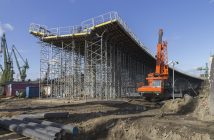A recent analysis by Frost & Sullivan has identified how the global construction materials market is set to change in 2021

The ongoing COVID-19 pandemic, renewed focus on environment-friendly and circular solutions and geopolitical issues are expected to affect the global construction industry for the next 10-15 years. The geopolitical chaos has led to disruptions in local and global preferences for construction materials.
“Over the next decade, the global construction industry is expected to shift toward sustainable construction practices that do not compromise quality, durability, and cost,” says Prathmesh Limaye, Senior Research Analyst at Frost & Sullivan.
“This will drive the development of sustainable materials, such as timber and wood, and is also promoting greater use of recycled materials.”
“Innovation is also happening with developers focusing on the unique utilization of bio-based materials such as cork and bamboo for structural and insulation applications in buildings, a trend which is likely to continue.”
Frost & Sullivan’s recent analysis, Key Architectural Trends Determining Construction Materials Usage, Outlook 2021, identifies eight predictions for the global construction materials market.
- Focus on sustainability: This is expected to drive the development of energy-efficient and recyclable construction materials globally.
- Increasing modularity: There will be greater implementation of offsite and prefab construction and modular construction within the industry, which reduces overall construction time.
- Increasing automation: To address the lack of skilled labor globally, construction developers are relying on automation tools and techniques such as building information modeling to boost productivity.
- Verticalization: Urbanization and the shift toward newer, slender and taller skyscrapers will drive the usage of materials such as thinner concrete, structural steel, and large and clear glass facades.
- Rise of DIY trends for home renovation activities: The markets witnessed a surge in online orders for do-it-yourself (DIY) home renovation materials. The need for home renovation was further magnified because of office closures and increasing work from home (WFH) by office workers during the pandemic.
- Development of open and multipurpose spaces: Architects and developers will focus on developing rooms that can provide multiple functionalities to work and relax.
- Increasing use of lightweight materials: There will be greater use of lighter construction materials, including construction plastics and composites (e.g., WPCs), which are cost-efficient and easier to install.
- Greater awareness of antimicrobial construction materials: Challenges with surface contamination will see increasing use of microbe-resistant coatings containing antimicrobial agents.
About Frost & Sullivan
For six decades, Frost & Sullivan has been world-renowned for its role in helping investors, corporate leaders and governments navigate economic changes and identify disruptive technologies, Mega Trends, new business models, and companies to action, resulting in a continuous flow of growth opportunities to drive future success.



